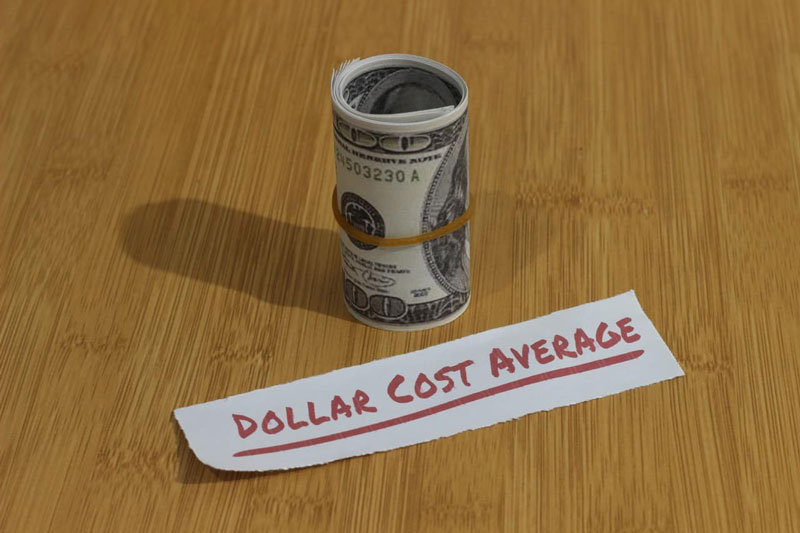The dollar-cost averaging method can help you save money on investments while reducing your risk exposure. With dollar-cost averaging, you acquire smaller stock quantities at regular periods, independent of the stock's current price. Dollar-cost averaging can help you save money on your investments while also increasing your profits over the long run.
How Does Dollar Cost Averaging Work?
You can manage price risk when you buy stocks, ETFs or mutual funds through dollar-cost averaging (DCA). Instead of investing all of your money at once, using dollar-cost averaging, you buy little amounts of a certain investment at regular periods. As a result, there is less danger of paying too much before the market drops.
Of course, prices don't just go up or down. You can, however, get a better deal if you spread out your purchase over a longer period. A major benefit of dollar-cost averaging is that it keeps your money working for you over the long run.
Price Sensitivity vs. Dollar Cost Average

Because asset values tend to grow over the long run, dollar-cost averaging is a good investment method. The short-term growth in asset values isn't constant. Many people have tried to time the market to acquire assets at a discount. Theoretically, this should be a piece of cake.
Even for experienced stock pickers, predicting the market's short-term direction is nearly impossible. This week's low might be next week's high. The recent high may appear to be a bargain a month from now. Once the dust has settled, it's too late to find out what an item might have sold for at a better price. Waiting on the sidelines and timing your asset acquisition often results in you buying at a price that has already plateaued rather than at a lower price.
What Is the Process of Dollar-Cost Averaging?
By regularly purchasing the same little quantity of an item, dollar cost averaging removes the emotional component of investing. This means that you purchase fewer shares when stock prices are high, and when stock prices are low, you buy more.
For example, let's say you're going to put $1,200 into Mutual Fund A this year. At the beginning or end of the year, you may invest everything you have—or you can invest $100 each month. If you stretch out your purchases over a year, you may own more shares than you would if you acquired them all at once.
Budget Investing Using Dollar Cost Averaging

Dollar-cost averaging makes it possible to start investing with tiny sums of money. For example, investing a huge chunk of money may not be an option for you. With dollar-cost averaging, you routinely invest smaller sums of money. There is no need to wait until you've accumulated a huge sum to reap the benefits of market expansion.
When the market is down, dollar cost averaging's monthly investments ensure that you're still investing. The danger of missing out on future gains if you stop investing or remove your capital in a down market is high.
How Effective Is Dollar-Cost Averaging?
Dollar-cost averaging rarely follows a straight line outside of hypothetical instances. Investing your money as soon as you get it is always a good idea when you have a lot of it. This study isn't to be taken at face value, though. Your savings may be little, and delaying investing might cause you to lose out on lucrative opportunities. You could find it less stressful to invest small amounts of money over time rather than a huge sum.
Is DCM Better Than Buying the Dip?
In certain cases, dollar-cost averaging is preferable to purchasing the dip since it gives you more exposure to price declines as they occur rather than waiting for one to happen. Furthermore, because of the set quantity, you will be able to purchase more shares at a cheaper price than you would at a higher price.
Why Do Some Investors Dollar-Cost-Av?
The main benefit of dollar-cost averaging is that it minimizes the impact of investor psychology and market timing on the portfolio. Investing with a dollar-cost averaging strategy protects investors from making unproductive decisions due to greed or fear, such as purchasing more when prices are increasing or panic-selling when prices are declining.
On the other hand, dollar-cost averaging compels investors to ignore the price of each particular purchase in favor of putting aside a predetermined amount each time.
What Is a Dollar-Cost Averaging Example?
You may use dollar-cost averaging by investing $500 per month in a wide market index fund like the S&P 500, for example. If the index is trading at a premium, fewer shares will be obtained for the $500 investment in some months. If the index is low, $500 would buy more shares in other months.
For investors, dollar-cost averaging is a long-term approach that they believe will yield greater returns than trying to timing the market on each individual purchase. This is because the technique is simple and protects them from the temptation of buying high and selling low.



